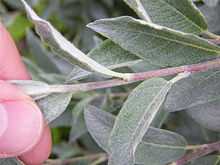Salix lapponum
From Wikipedia, the free encyclopedia
| Salix lapponum Downy willow | |
|---|---|
 | |
| Scientific classification | |
| Kingdom: | Plantae |
| (unranked): | Angiosperms |
| (unranked): | Eudicots |
| (unranked): | Rosids |
| Order: | Malpighiales |
| Family: | Salicaceae |
| Genus: | Salix |
| Species: | S. lapponum |
| Binomial name | |
| Salix lapponum L. | |
Salix lapponum, the downy willow, is a low, much branched shrub (to 1.5 metres) having a wide distribution in Northern Europe, eastwards to the Altai and western Siberia, and is found as far south as the Pyrenees and Bulgaria. In Scotland it can be found on rocky mountain slopes and cliffs, generally at altitudes between 200 and 900 metres.[1]

General view.

Upper surface of leaf.

Lower surface of leaf.

View showing twig and leaf petioles.
As described in Stace[2] and BSBI[1] Salix lapponum has the following characteristics:
- Twigs hairy at first, hairless and rather glossy dark reddish brown later.
- Leaves usually lanceolate to 7cm long by 2.5cm wide; slightly hairy to hairy on upper side; usually densely hairy on lower side; margins entire or subentire, sometimes a little undulate.
- Petiole short, occasionally up to 1cm long but usually less than 5mm.
References
This article is issued from Wikipedia. The text is available under the Creative Commons Attribution/Share Alike; additional terms may apply for the media files.